What is Nambu Tekki|Japanese traditional crafts with a history of more than 400 years
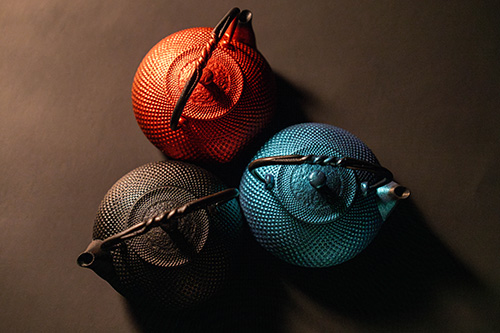
Nambu ironware is,Made mainly in Morioka City and Oshu City in Iwate Prefecture.It is a traditional iron casting craft. With a history of over 400 years, it is loved not only in Japan but also around the world for its unique manufacturing method and beauty.
This article will introduce the history, types, characteristics, and care of this Nambu ironware.
Article
History of Nambu Ironware
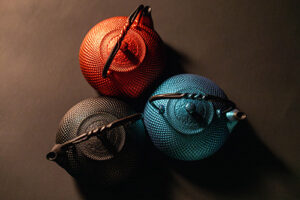
The history of Nambu ironware dates back to the early Edo period (1603-1868), when the Nambu clan, which took root in Iwate in the mid-17th century, sought to fuse the culture of the tea ceremony with casting techniques, laying the foundation for this traditional craft.
The land of Morioka is,Blessed with rich iron resources since ancient timesThe land was suitable for the development of the foundry industry. The Nanbu domain, taking advantage of this advantageous location, gathered skilled foundry workers and focused its efforts on the promotion of foundry production. At the same time, the lord of the domain, who had a deep knowledge of the tea ceremony, invited Koizumi Nizaemon I, a renowned potter from the capital of Kyoto, to establish a hot-water pot factory in the castle town in 1659.
Eventually, all tea kettles used by the Nanbu domain came to be made in this area, and the high quality of these kettles established their status as a gift item. As time went by, during the reign of Nizaemon Koizumi III, a more practical version of the chanoyu kettle callediron kettle from the southwas born. This innovative vessel quickly penetrated people's lives as a tool for boiling water.
In 1908, Nizaemon Koizumi VIII produced Nambu ironware in front of the Crown Prince (later Emperor Taisho) during his visit to the Tohoku region. This was reported in a national newspaper, and the name of Nambu ironware became known throughout the country. Today, the tradition of Nambu ironware is carried on in two major production centers in Iwate Prefecture: Morioka City and Mizusawa Ward, Oshu City.
Major production area of Nambu Ironware

Morioka City
Morioka's Nambu ironware is said to have originated in 1659, when the lord of the Nambu domain invited Koizumi Nizaemon I, a potter from Kyoto, to make kettles for the tea ceremony.1The Nanbu domain was a tea ceremony center in the southern part of the country. The lords of the Nanbu domain at that time had a deep knowledge of the tea ceremony, and since good iron resources were available in the domain, they came up with the idea of producing tea kettles for the tea ceremony in their own domain. Therefore, Morioka's Nambu ironware has strong historical ties to the tea ceremony culture.
Mizusawa Ward, Oshu City
The history of Nambu ironware (also known as Mizusawa cast ironware) in Mizusawa, Oshu City, goes back even further, to the late Heian Period. It is said to have originated about 950 years ago, when the Oshu Fujiwara clan, which ruled the Tohoku region centering on Hiraizumi, invited foundry workers from Omi Province (present-day Shiga Prefecture). In addition, Nambu ironware from Oshu is characterized by its development as an everyday household item, with an emphasis on functionality as a tool for daily use.
Features of Nambu Ironware
From here, we will look at the characteristics of Nambu ironware.
1. rust-resistant and long-lasting
Nambu ironware is baked at high temperatures during production, which forms an oxide film on the surface, making it resistant to rust. With proper care,It can be used for more than 100 years.The following is a list of the most common problems with the
2. uniform heat transfer
Due to the excellent thermal conductivity of iron, Nambu ironware transfers heat evenly. This allows for the delicious preparation of food.
3. excellent heat retention
Nambu ironware has the property of retaining heat for a long time.Heat lasts 1.5 times longer than aluminum potsThis makes it energy efficient and suitable for maintaining food temperatures.
4. unique texture
Nambu ironware is characterized by its rough texture and massive appearance. Despite its rustic and rugged appearance, it has a deep beauty. It is also characterized by the fact that the more it is used, the more it tastes and develops different textures depending on the environment in which it is used.
5. iron supplementation
By using Nambu ironware, the iron is dissolved into the food,Provides iron in a natural formThe iron that is leached from Nambu ironware is divalent iron. Because Nambu ironware elutes divalent iron, which is easily absorbed by the body, it has been attracting attention in recent years from a health standpoint as well.
Types of Nambu Ironware
You may have an image that "Nambu Tekki is an iron kettle," but there are many different types of Nambu Tekki. The main ones are as follows.
iron kettle
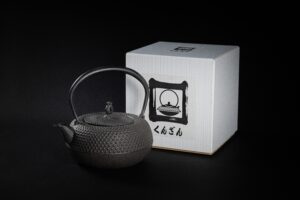
This is a typical Nambu ironware product. It is used to boil water and can be placed over an open flame. The surface is decorated with various patterns, the most distinctive of which is the "arare pattern" (with bumpy protrusions on the surface).
Our store handles tetsubin that are compatible with induction stoves.
> Click here for the sales website.
iron teapot
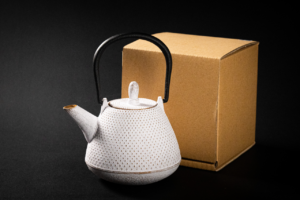
The inside is coated with enamel and used to make tea. It cannot be placed over an open flame.
Iron pots and pans
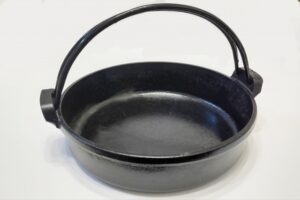
Some products are compatible with induction cooktops.
wind chime
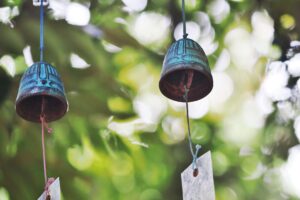
Wind chimes that utilize Nambu ironware techniques are also popular. They are characterized by their cool tone.
Other
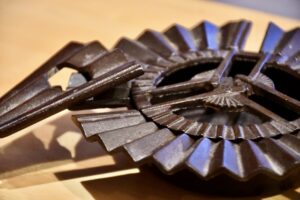
Various products such as pots and pans, objets d'art, and accessories are made to suit modern lifestyles.
Manufacturing Process of Nambu Ironware
The production of Nambu ironware involves the following processes
Design and mold making
First, the design of the ironware is determined and drawings are made. Then, a wooden mold is made to create the mold, and the mold is formed using sand and clay. During this process, preparations are also made to apply the unique patterns and textures of Nambu ironware.
Casting
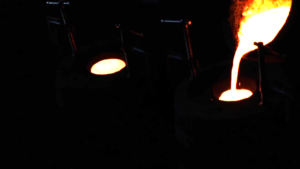
This is the process of pouring molten iron into a mold. After preparing cores for the inner cavity and combining them with the mold,Pouring iron heated to 1300-1400 degrees CelsiusThis creates the basic form of ironware.
Molding and Finishing
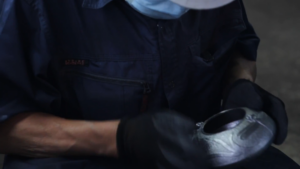
Once the iron has cooled and hardened, the mold is removed and the product is taken out. The surface is then polished and unnecessary parts are shaved off to complete the ironware.
Quenching and Rust Prevention
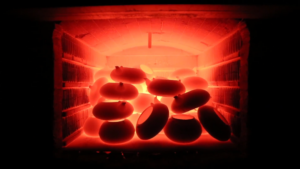
To prevent rusting, the pieces are fired over a charcoal fire at 800 to 1,000 degrees Celsius to form an oxide film on the surface. In addition, coloring treatment using lacquer or iron acetate solution is applied to give Nambu ironware its distinctive beautiful coloring and rust-preventing effect.
Final finishing and assembly
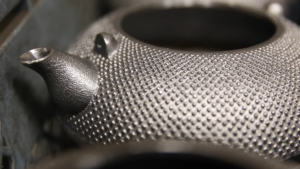
The vines (handles), lids, and other parts of the tetsubin are attached, and a final quality check is performed. After the craftsmen have made adjustments down to the smallest detail, the finished Nambu ironware is sent out to the market.
Thus, Nambu ironware is carefully made one by one through a long process, and is sent out to the world as a gem of traditional techniques.
How to use and care for Nambu Ironware
Proper use and care of Nambu ironware are important for its long use.
iron kettle
when using
- Rinse the interior lightly with water.
- Pour in hard water to the eighth part and bring to a boil for 20 minutes.
- Discard the hot water and use the residual heat to dry the interior.
This process is repeated three times.
after use
- Allow the water inside to dry completely.
- During rainy season or other seasons when it is difficult to dry out, it is recommended to cook the rice empty for 10 to 20 seconds.
iron teapot
- At the beginning or after use, wash the inside, the tea strainer and the lid in hot water with a soft sponge.
- After use, wipe dry with a dry cloth and dry well.
- Cannot be placed over an open flame.
iron pan
At the time of use (oil conditioning)
- Rinse with a scrubbing brush, and then heat over low to medium heat to allow the water to evaporate.
- Lower the heat and add enough oil to cover the bottom of the pan, add the chopped leafy greens and saute for 2-3 minutes.
- Remove the vegetables and rinse with water using a scrubbing brush once the iron pot has cooled.
after use
- Wash with water using a natural scrubber or brush, without cleanser.
- After cleaning, wipe dry and allow to cool by emptying.
Store where you can buy Nambu Ironware in Sapporo
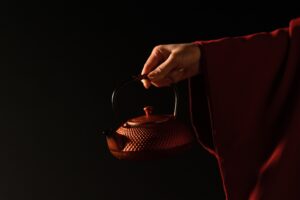
At "Japanese Modern N6 Kita Maruyama," located in Kita Maruyama, Sapporo, we offer a wide range of traditional Japanese crafts, includingYou can actually hold Nambu Ironware in your hands and check the feel before purchasing.The shop offers a wide range of Nambu tetsuwares. We have a selection of Nambu ironware that is easy to incorporate into daily life, such as tetsubin (iron kettles) and kyusu (teapots), allowing visitors to experience up close the texture, weight, and beauty created by the craftsmen's techniques.
At this facility, the texture and the use of Nambu ironware will become more and more distinctive as it is used more and more,Sense of massiveness peculiar to iron castingsYou can directly experience the In addition to functionality, the products range from sophisticated designs that fit in with modern living to a wide range of color variations,Items that harmonize with a variety of spaces, both Japanese and Westernare also available.
Please come to the store of Japanese modern N6 Kita Maruyama where you can actually feel the charm of Nambu ironware with more than 400 years of history while you are in Sapporo.
The Appeal of Nambu Ironware and Its Evaluation in Modern Times
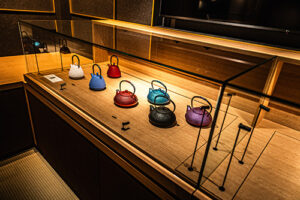
Nambu ironware is highly regarded both domestically and internationally for its high functionality and beauty.
Domestic Assessment
In 1975, Nambu ironware was recognized as a national traditional craft. Its rustic and deep flavor matches the Japanese sense of beauty and is loved by many people.
Overseas Evaluation
Recent years,Nambu ironware has gained great popularity, especially in Europe and ChinaThe design of tetsubin/kyusu is attracting attention in Europe. In particular, colorful and stylishly designed tetsubin/kyusu (iron kettles) are attracting attention in Europe. In China, water boiled in Nambu tetsubin teapots is popular for its suitability for Chinese tea, and was also exhibited at the 2010 Shanghai World Expo.
summary
Nambu Tekki not only produces traditional products, but also develops products adapted to modern lifestyles. Many products that can be easily incorporated into daily life, such as frying pans, pot holders, and candleholders, are being produced. In addition, Nambu tetsubin are being developed to meet the needs of the times, such as Nambu ironware with a plum blossom motif to commemorate the new era, and iron kettles made in collaboration with popular characters.
Nambu ironware is a traditional Japanese craft with a history of over 400 years. Its superior functionality and unique beauty have been loved by many people throughout the ages. A wide range of products are made, from practical products such as iron kettles and frying pans to decorative items such as wind chimes and accessories, all of which fit well into modern life.Nambu ironware is not just a tool, but a crystallization of Japanese culture and technology.. When used properly and carefully cared for, they become valuable objects that can be passed down from generation to generation. Using Nambu ironware is also a way of preserving traditional Japanese craftsmanship.
